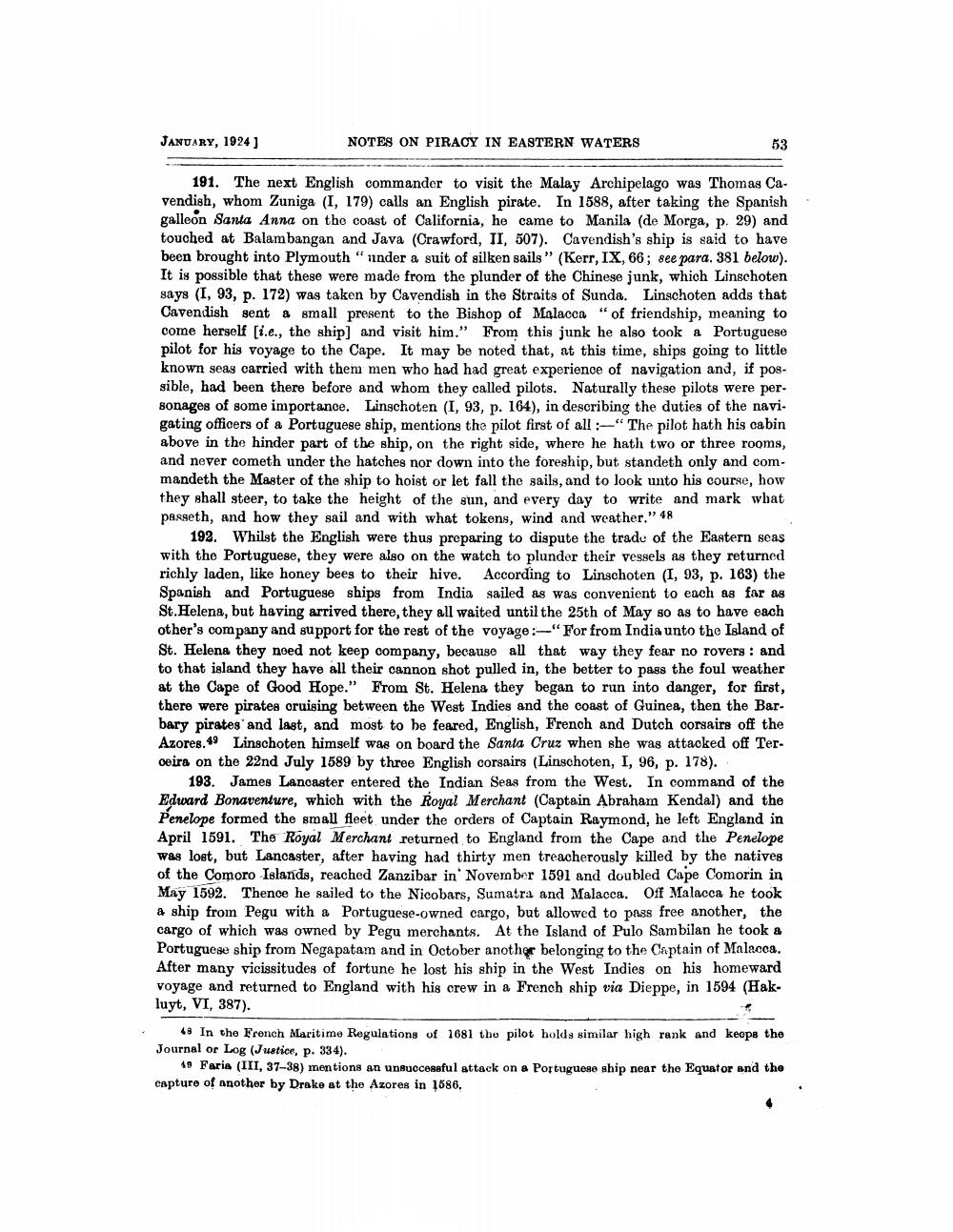________________
JANUARY, 1924 ]
NOTES ON PIRACY IN EASTERN WATERS
53
191. The next English commander to visit the Malay Archipelago was Thomas Cavendish, whom Zuniga (I, 179) calls an English pirate. In 1588, after taking the Spanish galleon Santa Anna on the coast of California, he came to Manila (de Morga, p. 29) and touched at Balambangan and Java (Crawford, II, 507). Cavendish's ship is said to have been brought into Plymouth" under a suit of silken sails" (Kerr, IX, 66; see para. 381 below). It is possible that these were made from the plunder of the Chinese junk, which Linschoten says (I, 93, p. 172) was taken by Cavendish in the Straits of Sunda. Linschoten adds that Cavendish sent a small present to the Bishop of Malacca" of friendship, meaning to come herself [i.e., the ship) and visit him." From this junk he also took a Portuguese pilot for his voyage to the Cape. It may be noted that, at this time, ships going to little known seas carried with them men who had had great experience of navigation and, if possible, had been there before and whom they called pilots. Naturally these pilots were personages of some importance. Linschoten (I, 93, p. 164), in describing the duties of the navi. gating officers of a Portuguese ship, mentions the pilot first of all :-"The pilot hath his cabin above in the hinder part of the ship, on the right side, where he hath two or three rooms, and never cometh under the hatches nor down into the foreship, but standeth only and commandeth the Master of the ship to hoist or let fall the sails, and to look unto his course, how they shall steer, to take the height of the sun, and every day to write and mark what passeth, and how they sail and with what tokens, wind and weather." 48
192. Whilst the English were thus preparing to dispute the trade of the Eastern seas with the Portuguese, they were also on the watch to plunder their vessels as they returned richly laden, like honey bees to their hive. According to Linschoten (I, 93, p. 163) the Spanish and Portuguese ships from India sailed as was convenient to each as far as St. Helena, but having arrived there, they all waited until the 25th of May so as to have each other's company and support for the rest of the voyage "For from India unto the Island of St. Helena they noed not keep company, because all that way they fear no rovers : and to that island they have all their cannon shot pulled in, the better to pass the foul weather at the Cape of Good Hope." From St. Helena they began to run into danger, for first, there were pirates cruising between the West Indies and the coast of Guinea, then the Barbary pirates' and last, and most to be feared, English, French and Dutch corsairs off the Azores.49 Linschoten himself was on board the Santa Cruz when she was attacked off Teroeira on the 22nd July 1589 by three English corsairs (Linschoten, I, 96, p. 178).
193. James Lancaster entered the Indian Seas from the West. In command of the Edward Bonaventure, which with the Royal Merchant (Captain Abraham Kendal) and the Penelope formed the small fleet under the orders of Captain Raymond, he left England in April 1591. The Royal Merchant returned to England from the Cape and the Penelope was lost, but Lancaster, after having had thirty men treacherously killed by the natives of the Comoro Islands, reached Zanzibar in November 1591 and doubled Cape Comorin in May 1592. Thence he sailed to the Nicobars, Sumatra and Malacca. Off Malacca he took a ship from Pegu with a Portuguese-owned cargo, but allowed to pass free another, the cargo of which was owned by Pegu merchants. At the Island of Pulo Sambilan he took a Portuguese ship from Negapatam and in October another belonging to the Captain of Malacca, After many vicissitudes of fortune he lost his ship in the West Indies on his homeward voyage and returned to England with his crew in a French ship via Dieppe, in 1594 (Hakluyt, VI, 387).
49 In the French Maritime Regulations of 1681 thu pilot holds similar high rank and keeps the Journal or Log (Justice, p. 334).
19 Faria (III, 37-38) mentions an uniuocessful attack on a Portuguese ship near the Equator and the capture of another by Drake at the Azores in 1886.




